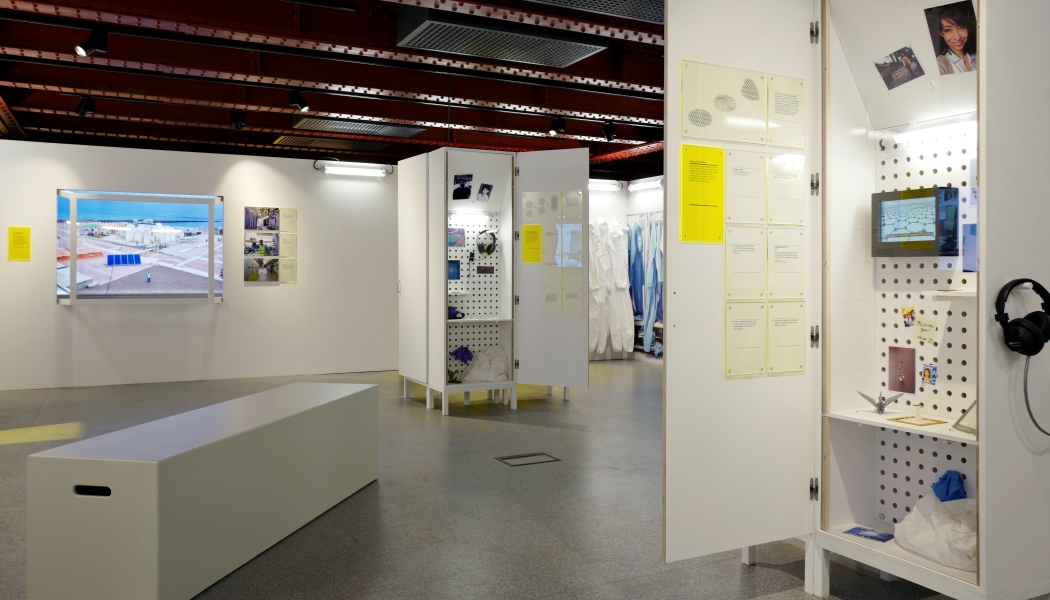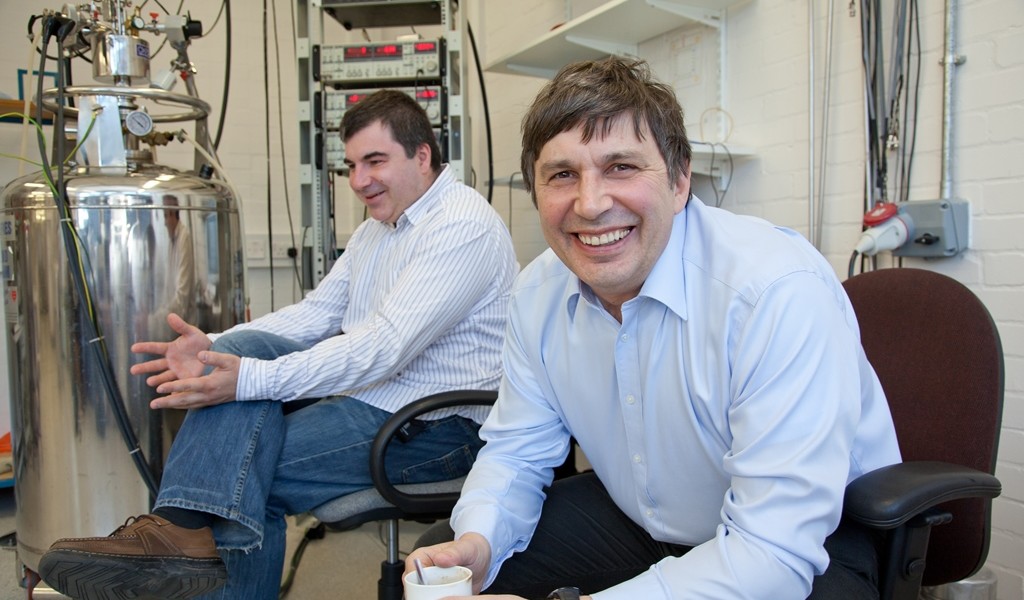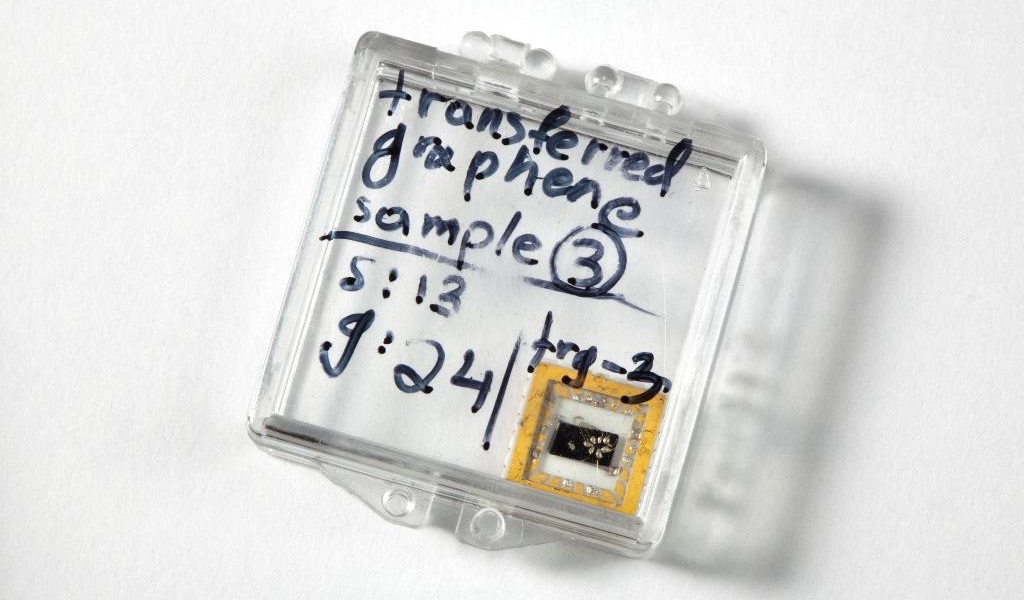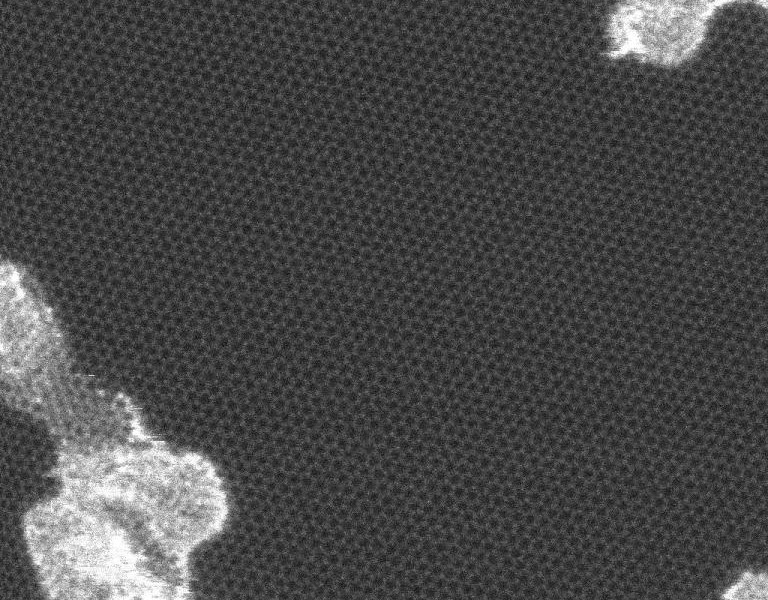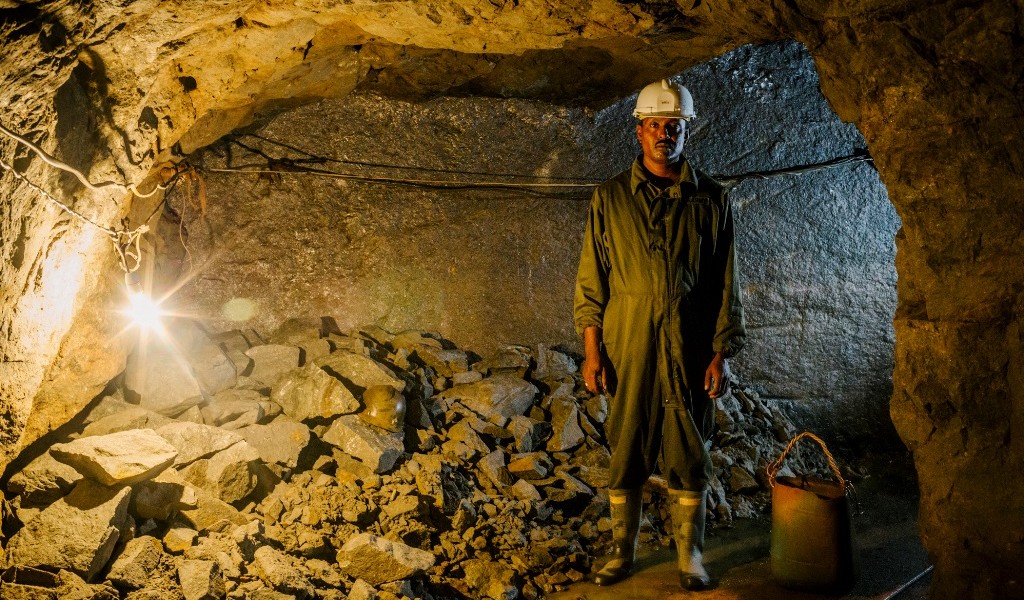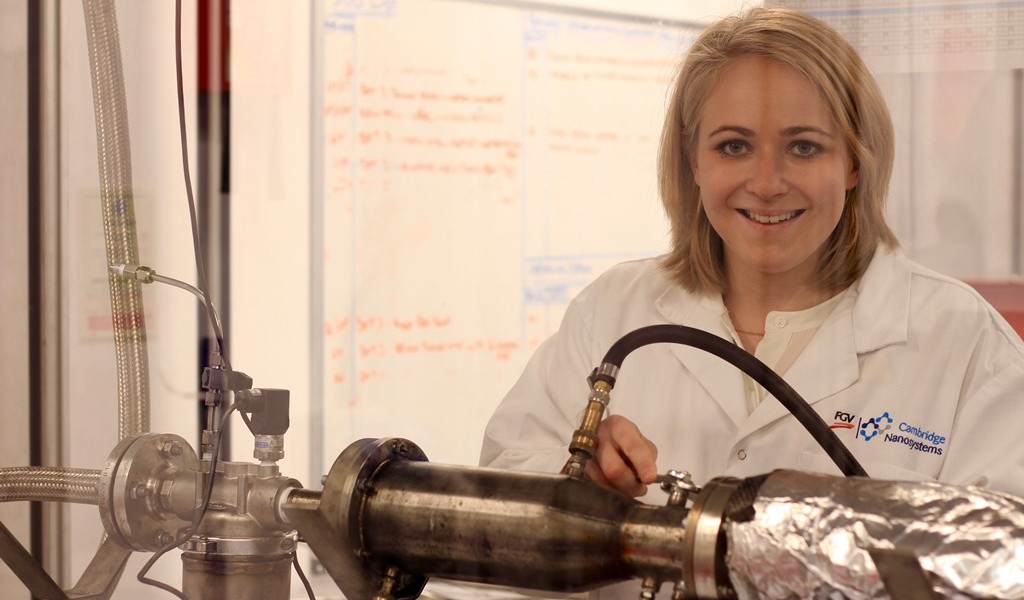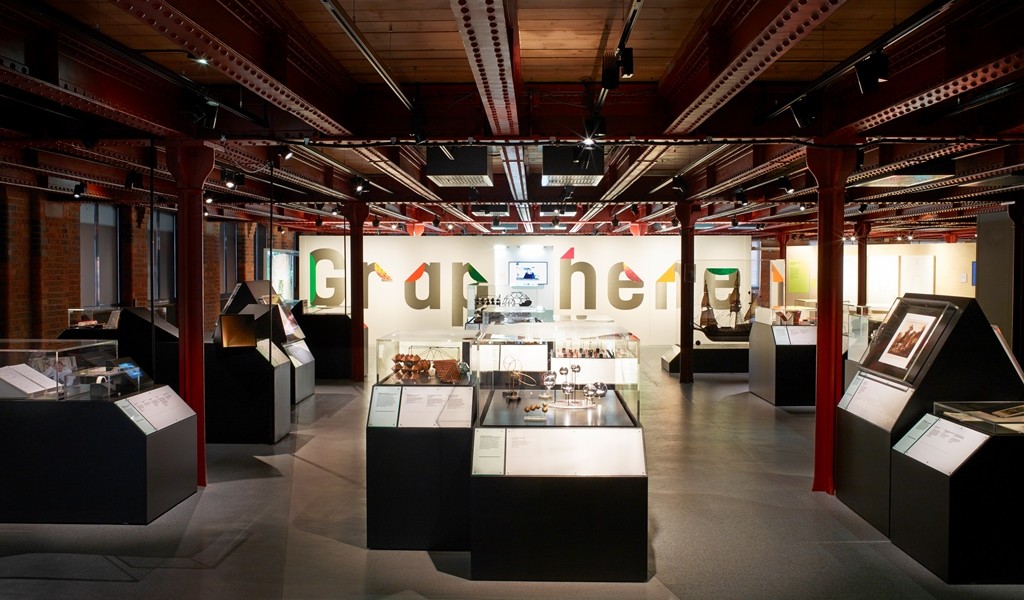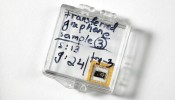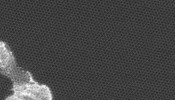The isolation of graphene in 2004 at the University of Manchester by professors Andre Geim and Kostya Novoselov did not happen during their normal ‘office hours’ but at one of their Friday night, after-work labs. Their discovery was so important that six years later they were awarded the Nobel Peace Prize in Physics. Fast forward a further six years and the UK’s first exhibition dedicated to graphene tells the story of the scientists’ playful approach to their work in the hope of inspiring visitors and breaking down some of the prejudices related to science.
Working closely with the NGI, a research institute looking at the application and commercialisation of graphene which opened a new £61m facility at the university last year, curators have been able to magnify the narrative of a material that is invisible to the naked eye.
Scientists have known for decades that graphite, used in the Elizabethan era to line cannonballs and more commonly in pencils, was made up of flat 2D crystals called graphene, however, it was not until one Friday night that the two scientists removed some flakes from a lump of bulk graphite with sticky tape and noticed some flakes were thinner than others. By separating the graphite fragments repeatedly they managed to create flakes which were just one atom thick. They had isolated graphene for the first time.
This development has meant that a material a million times thinner than paper but 200 times stronger than steel is now able to be explored, and its potential to transform entire industries, and possibly address pressing global concerns, has become a possibility.
“To find a new material is very nice and maybe important, but to find a whole class of new materials … this happens very rarely in the story of man,” said Andre Greim.
Wonder Materials: Graphene and Beyond at MOSI explores, through science, art, history and interactive displays how graphene, made from a single, one-atom layer of carbon is invisible to the naked eye but has the potential to transform many sectors such as energy, electronics (including mobile phones) and healthcare.
“The way I set out with this exhibition is from the curious outsider. Dive in at the deep end and bring up the extraordinary discovery and then take people on this journey,” said co-curator Danielle Olsen. “We ask the questions: what is this thing and where did it come from – there’s a long way to go and a long journey ahead to realise its potential.”
Olsen says there is the story of the Eureka moment but also the decades of theorising before that. The history of graphene is an interesting one in its own right, she says, including graphite in pencils, and the exhibition hints of what’s to come. “There is also the playful story of the scientists – they are very maverick the way they work – and there’s always the question of how do we visualise what we can’t see,” she says.
The exhibition is split into four sections: the Past, Present, Future and Imagined. In the present visitors step into a clean room and meet contemporary explorers of this material and discover what it’s for and how we can use it. The curators chose six scientists who are at the cutting edge of graphene research and manufacture to tell visitors their story.
For example, Roman Gorbachev a Royal Society University Research Fellow at the NGI has been layering 2D materials to find new ‘species’ or materials. “Since graphene opened the door, the discovery of many 2D materials has followed,” he tells visitors. “There are still many undiscovered 2D crystals to find. The exploration into the super-thin, single-layer materials is a whole new frontier in science.”
The exhibition shows how graphite is taken from a mine in Sri Lanka and how graphene is being used in a water desalination plant in Abu Dhabi and a mobile phone factory in China. It also shows how graphene can be converted from greenhouse gases such as methane, which is what Catharina Paukner, chief scientist and founder of Cambridge Nanosystems does, and who also features as one of the six scientists. “Reliable, standardised supplies of graphene are essential in order for it to become a commercial success,” she says.
Wonder Materials: Graphene and Beyond was conceived following the establishment the NGI and during the European City of Science Manchester 2016.
“The NGI has been a really important go to place for this exhibition as well as having the scientists on hand to check the work as we go along,” says Olsen. “I am always interested in how you share and encourage curiosity in the world and physics has a reputation for being a hard subject. But with the right people to show the way it is something people can enjoy and interpret.”
The exhibition is entitled Wonder Materials but Olsen says it’s not in a supreme context, it’s about the frontier of knowledge and how the scientists can enable society to decide what we want to use it for and make new priorities. “It throws your prejudices of what science is doing and exhilarates and excites people into finding more out for themselves,” she says.
The design was completed by Universal Design Studio whose director, Jason Holley, says that designing an exhibition about a material that is transparent and just one atom thick presented a big challenge. “This required us to tell the story behind graphene taking the audience on a scientific journey of discovery, through the past, present and into the imagined future of this new material landscape.”
Holley says that in order to tackle this invisible subject matter the exhibition engages many different creative disciplines and interpretive approaches. “This includes 3d Design, graphics, Art, illustration, poetry and music in order to bring to life museum curated content and create new content speculating on this ‘wonder material’,”
One of the big challenges Holley says was how to make the exhibition intriguing and memorable but also make the science of graphene accessible to a wide, non-specialist audience encouraging them to imagine the future. “How could we encourage visitors to ask the big question – what could graphene mean for me? – In ‘Wonder Materials: Graphene and Beyond’ the exhibition design becomes content with interpretation techniques supporting overall narratives of the different areas. Visitors are encourage to engage in ways of looking akin to a scientist, at times looking in and closely focused and at others looking out to the horizon.”
The exhibition is expected to tour nationally and internationally, including going to the Science Museum, London, in 2018.
Wonder Materials: Graphene and Beyond runs at the Museum of Science and Industry until June 2017.
Wonder Materials: Graphene and Beyond
Curators: Danielle Olsen and Sarah Baines
Design: Universal Studios
Graphic design: LucienneRoberts+
Sponsor: Haydale
Funding: Engineering and Physical Sciences research Council, People’s Postcode Lottery
Highlights of the exhibition include:
- A new specially commissioned art installation by Random International. Everything and Nothing has been developed following their residency at the National Graphene Institute and is the collective’s first public commission in the UK since their internationally acclaimed Rain Room
- A provocative new work by acclaimed poet Lemn Sissay MBE, The World Wakes is a call for creative ideas to realise the potential for graphene to change our lives
- A fascinating array of objects which bring the graphene story to life; from a graphite-coated Elizabethan cannonball and Rutherford’s atomic models to the famous sticky tape dispenser which began the story of graphene’s isolation
- An investigation into the scientific breakthroughs made by scientists and professionals at the cutting edge of graphene use around the world
- An immersive recreation of a white room at the National Graphene Institute, where visitors can discover cutting edge applications of graphene use around the world and the personalities of the scientists who are developing them
- New documentary photography by PANOS, showcasing current uses of graphene internationally, from a desalination plant in Abu Dhabi to a mine in Sri Lanka producing high purity graphite for turning into graphene
- An interactive exhibit from Bare Conductive which invites audiences to imagine remarkable graphene products of the future – from clothing with built-in computer power to electricity-generating windows

